Community Education
Pioneer Elementary students launch near-space balloon, and the marigolds survived … barely
Exciting news from the world of space exploration last week.
Education Sponsor
Education stories are made possible in part by Tacoma Community College, a proud sponsor of Gig Harbor Now.
No, not the Boeing Starliner carrying astronauts to the International Space Station, although that was cool. We’re talking about Pioneer Elementary School’s near-space balloon launch Friday. It was quite the adventure.
The marigolds survived … barely. Recovering the balloon took an act of heroism — well, OK, let’s call it good-natured generosity — on the part of a stranger nearly 35 miles away. The Pop Rocks did not behave as expected.
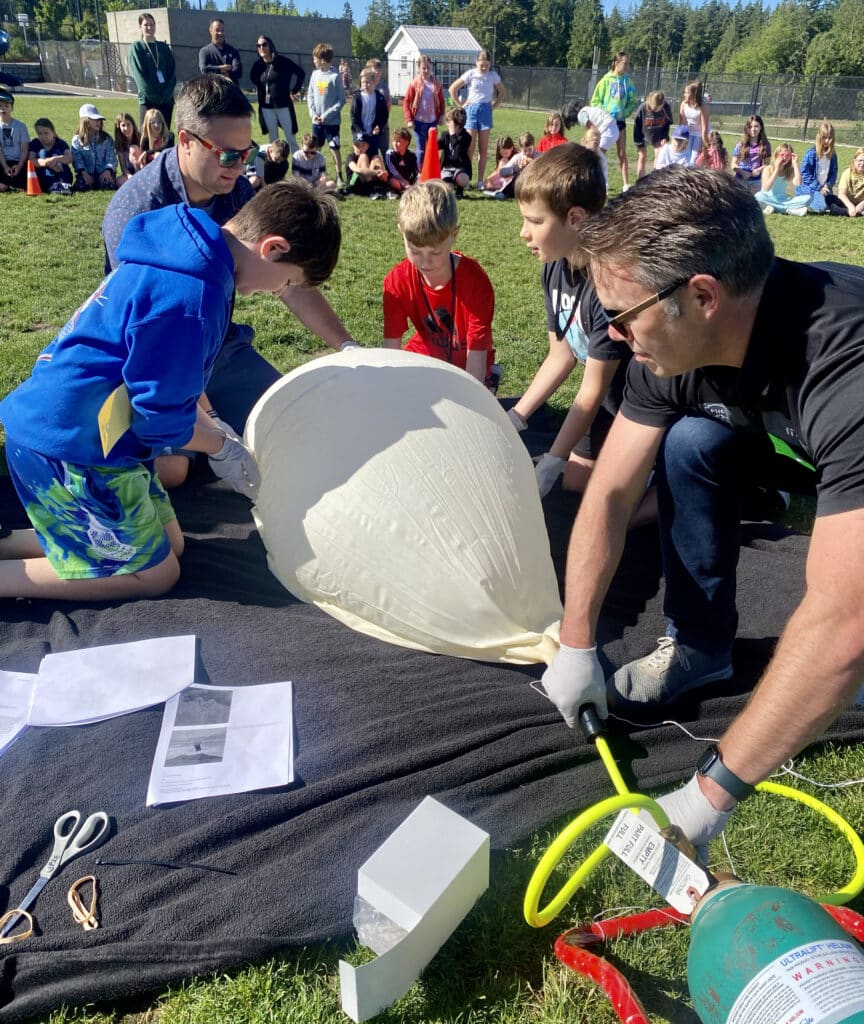
Students and volunteers fill the near-space balloon with helium before launch on June 7, 2024, at Pioneer Elementary School. Photo by Christina T. Henry
Second annual balloon launch
The balloon traveled 78,146 feet high, about twice the altitude of a commercial airplane. That’s not quite out of our planet’s atmosphere, but it is so high its cameras caught the curvature of the earth, landforms of the wider Puget Sound region below and the inky blue of space.
How cold was it up there? Last year’s mission, in which the balloon ascended to 95,280 feet, logged a temperature of minus 31 degrees. Surprisingly, the marigolds on this year’s flight seemed OK with the near-space conditions. It was the landing and aftermath that nearly did them in.
This year’s balloon, aptly named Near Space Balloon, launched at just after 9 a.m. Friday under the direction of Justin Towner, the school’s innovation specialist. Pioneer’s entire student body of 500 cheering kids, whipped up by Rhubarb the Tacoma Rainiers’ mascot, joined the countdown: 3, 2 ,1, and the launch team let ‘er rip.
The balloon, made of latex and filled with 110 cubic feet of helium, measured about 10 to 12 feet in diameter. It rose at a good clip, and was soon just a small speck of white in the bluebird sky.
Seventeen minutes post-launch, the balloon was 12,100 feet up, heading southwest.
Preparing for the mission
Pioneer Elementary is Peninsula School District’s only STEAM magnet school, with a focus on science, technology, engineering, art and math. Students apply to enroll and come from all over the district.
Towner’s job is to introduce the entire student body to scientific concepts and innovation through hands-on, experiential learning and real-world problem solving. Concepts Towner covered as part of the balloon launch unit included aerodynamics, climatology, geography, atmospheric science and biology.
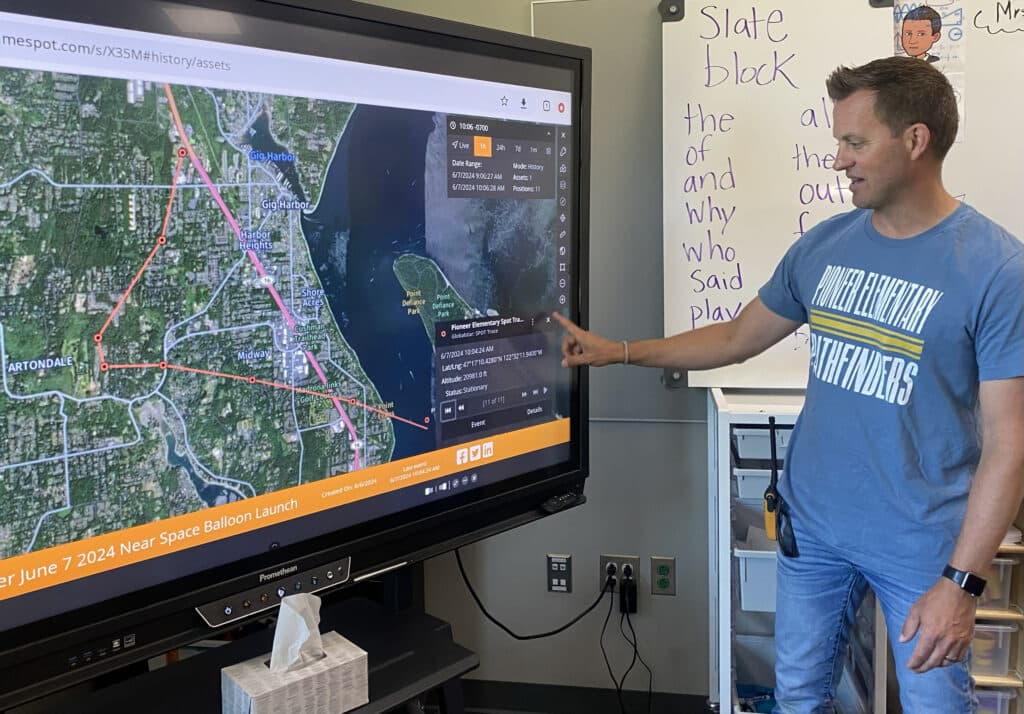
Justin Towner, innovation specialist at Pioneer Elementary School, shows students and guests the flight path of a near-space balloon launched from the school on June 7, 2024. Photo by Christina T. Henry
All of Pioneer’s students were invested in the balloon’s mission, from the big kids about to move on to middle school down to kindergarteners like Scarlett Marshall, who watched the launch wearing fancy pink sunglasses. A launch crew, made up of a dozen fourth- and fifth-grade students selected by teachers or peers, planned experiments and nailed down logistical details for the mission.
This year’s payload included two flight computers to collect data, three cameras and a GPS tracker for location. New this year was the StratoTrack transmitter that uses radio signals to send back live data, including altitude, speed, location and more.
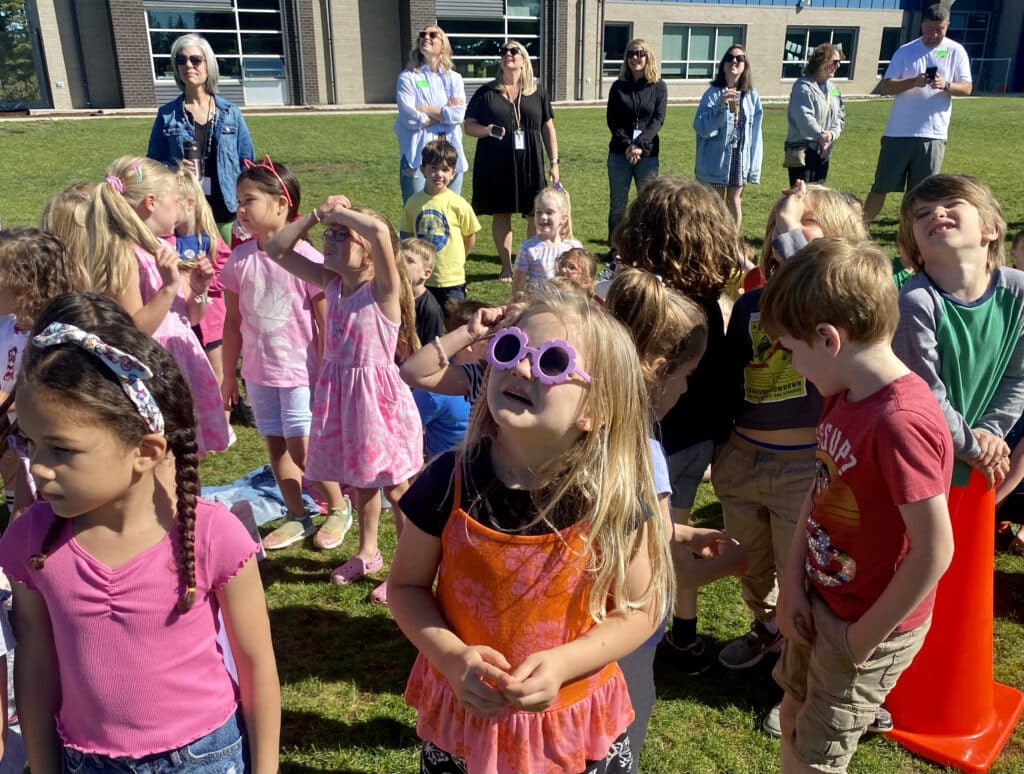
Kindergartener Scarlett Marshall watches the near space balloon as it rises in the sky following liftoff on June 7, 2024, at Pioneer Elementary School. Photo by Christina T. Henry
Pop Rocks and marigolds
In months leading up to the launch, students experimented with smaller party balloons to grasp the variables of lift, thrust and weight.
The students considered a number of potential experiments. Sending ice cream into near space was a briefly considered non-starter. This year’s experiments included a mood ring to gauge the effect of temperature changes and small balloons expected to explode as the atmospheric pressure decreased. Students put Pop Rocks on board, hypothesizing that the candy would pop in the thin air. Marigolds from the school’s garden were launched with the payload to see the impact of both temperature and air pressure on living things.
Maddie Dowdle, a member of the launch team, said she was “excited about how high it’s going to go, especially with the wind, and how the mood ring and flower are going to react, because you never know how cold it is up there until you send something up there to test it.”
Her prediction on the flowers: “They’re either going to probably freeze, wither and die, or they’re going to somehow survive.”
Predicting balloon’s flight path
Pioneer gets its near-space balloons from High Altitude Science, a company that supplies experimental balloons to schools, research labs and government organizations. Towner selected a mid-sized model dubbed by the company “the little engine that could.” It has a typical burst altitude of 95,000 to 105,000 feet.
Last year’s balloon reached 95,280 feet before the difference in atmospheric pressure inside and out caused the latex to rupture. Atmospheric pressure near sea level is about 15 psi (pounds per square inch). At 95,000 feet, it’s 0.1 psi.
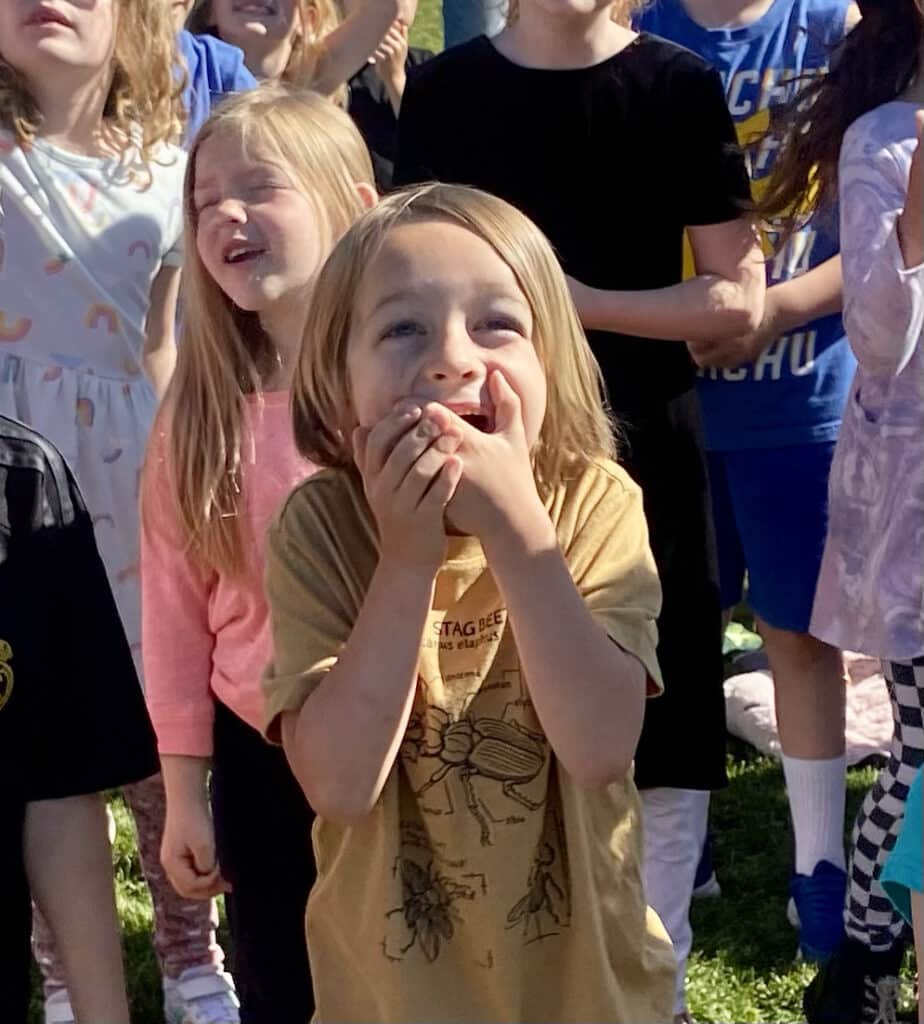
A Pioneer Elementary student watches in excitement as the near space balloon rises in the sky following liftoff on June 7, 2024. Photo by Christina T. Henry
Towner was optimistic shortly after launch.
“Our goal is 100,000. We’d love to break the 100,000-foot club,” he said.
The week before launch, their flight path prediction app, which factors in multiple variables, showed the balloon heading east toward Snoqualmie Pass. By Friday, the path had changed significantly, with the balloon projected to land near Point Defiance in Tacoma.
Towner notified the FAA in advance of launch date and received final clearance around 6 a.m. Friday.
The kindness of strangers
Last year’s balloon came down near Point No Point in North Kitsap. Towner retrieved it via kayak. This year’s payload was heavier than last year’s, which may account for its slower ascent and lower burst altitude.
The balloon rose at 10.37 feet per second. StratoTrack data showed it traveling southeast over Tacoma and past Bonney Lake, where it made a large, lazy zig zag. It burst 1 hour and 56 minutes into its flight at 78,146 feet. A parachute deployed, and the payload landed 42 minutes later southeast of Enumclaw, 34.1 miles from Pioneer. Towner located the balloon 60 feet up a tree.
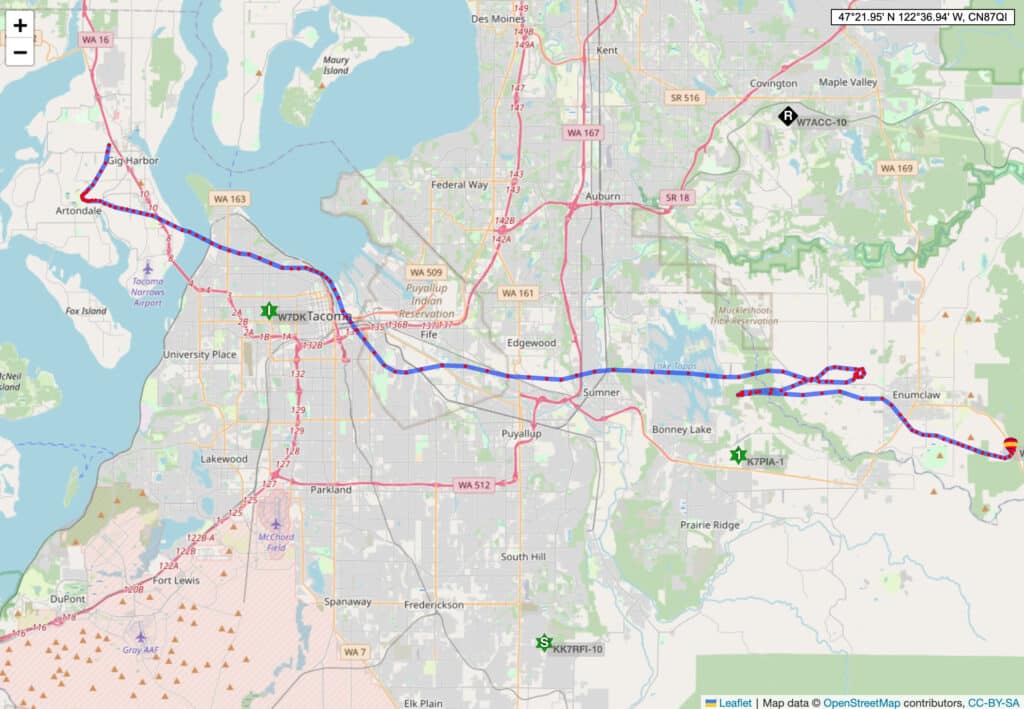
The StratoTrack app shows the path of Pioneer Elementary School’s near space balloon on June 7, 2024. It landed near Enumclaw, 60 feet up in a tree and was retrieved by a local logger.
“After venturing into Enumclaw to visit the hardware store, rental company and chatting with locals, one name kept coming up,” Towner said.
Wes Bruhn, owner of Bruhn Logging & Tree Services, agreed to retrieve the balloon. He brought his spider lift and his 13-year-old son Wade, who helped untangle the lines. All experiments and gear were recovered.
“I’ve rescued lots of cats, drones, remote control airplanes, but never a balloon,” Bruhn said. “I could tell he was in a tight spot, and this was a great opportunity to help him out.
Takeaways for next year
The mission had its glitches. One of the cameras shut off seconds before launch, so no downward video was recorded. The marigolds were damaged in the landing.
“They seemed healthy at burst, but clearly the impact and sitting in the hot sun for a bit did them in,” Towner said. “I will be taking them back to school tomorrow, and kids can replant them in our school garden and work to regrow.”
There were some unexpected results. The Pop Rocks “seemed to coagulate a bit and harden up,” he reported.
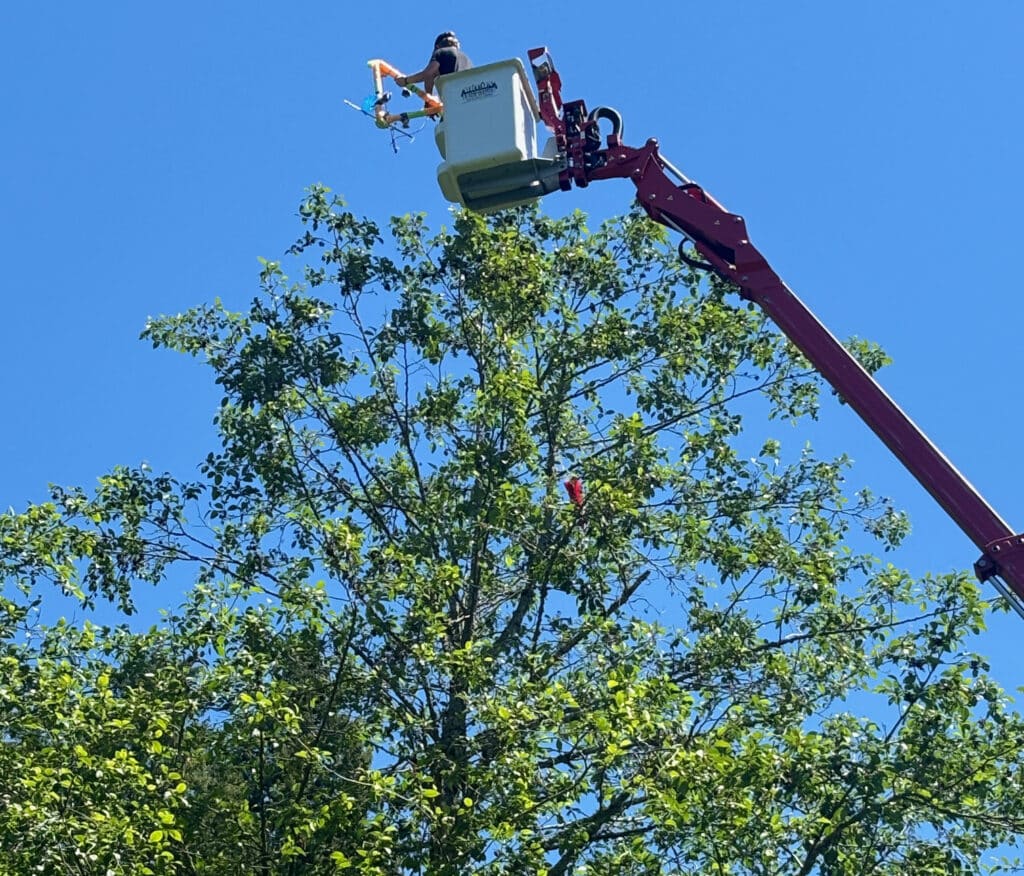
Wes Bruhn, owner of Bruhn Logging & Tree Services of Enumclaw, and his 13-year-old son Wade retrieved a near space balloon launched by students at Pioneer Elementary School in Gig Harbor on June 7, 2024.
Towner and his students will use the rest of the school year to review data, video and experiments. What they discover will inform Pioneer’s near-space balloon launch 2025.
“The biggest thing I’ve learned is you can do anything you put your mind to,” Dowdle said, “And if you fail, just get back on your feet and try again.”
But of course in this business, there are no failures, only learning opportunities.

A Pioneer Elementary student watches in excitement as the near space balloon rises in the sky following liftoff on June 7, 2024. Photo by Christina T. Henry

